Liquid wallpaper in the kitchen: pros, cons and finishes

The kitchen is one of the most important rooms in the house, where not only food preparation takes place, but family dinners and guests are also held. Each hostess wants to make this room functional and practical, modern and beautiful. Today, designers recommend using not only traditional materials for decorating the kitchen, but also new types of finishes. Innovative technologies and modern equipment have allowed manufacturers to establish the production of liquid wallpaper, which makes it possible to create both monochromatic and multi-colored wall coverings.


What it is?
Liquid wallpaper for the kitchen is an actual type of finishing material, which is widely used in modern interiors, as it has high hypoallergenic properties and the absence of an unpleasant odor.


The main components that make up liquid wallpaper:
- cellulose;
- cotton or silk threads;
- binding solutions;
- colored pigments;
- colored flock;
- marble chips;
- sparkles.

Advantages and disadvantages
This type of materials has similarities with plaster and has both positive and negative sides.
First, we list all the advantages, of which there are many:
- environmental Safety;
- high aesthetic performance;
- wide price range;
- modern design;
- ease of transportation;
- wide range of colors;
- lack of seams;
- long period of operation;
- absence of toxic emissions during combustion;
- the ability to add small decorative elements to the mixture;
- ease of application without professional skills and special tools;
- lack of substances that provoke allergic reactions;
- the ability to use in premises for various functional purposes;
- creation of an additional heat-insulating and noise-insulating layer;
- the ability to apply to unaligned walls;
- a high level of elasticity, which makes it possible to use the material for finishing the most difficult and problematic areas;
- vapor permeability and good air exchange, which does not allow the development of fungi and mold;
- absence of deformed areas during natural shrinkage of the building;
- fast restoration of damaged areas with a minimum amount of time and financial costs;
- lack of electrostatic voltage;
- resistance to temperature extremes;
- cleaning the premises after renovation using a conventional vacuum cleaner.


Cons, there are few of them:
- low level of wear resistance;
- undesirable use in walk-through areas;
- loss of brightness and color saturation under the influence of ultraviolet radiation;
- the appearance of yellow spots on contact with iron;
- the complexity of the preliminary calculation of the required material;
- the presence of a large amount of dust during work;
- absorption and long-term retention of foreign odors;
- low resistance to moisture;
- complete drying of the composition within 72 hours.
Taking into account all of the above characteristics, experts recommend necessarily covering kitchen walls, finished with liquid wallpaper, special varnishes and protective compounds based on acrylic or water, which will not only increase their service life, but also prevent pollution and the accumulation of unpleasant odors in them.


Despite all the measures taken to increase the resistance of wallpaper to the action of negative factors, experts do not recommend making a kitchen apron from this material.


Views
On the shelves of modern stores, you can see a wide range of liquid wallpaper, which differ in raw materials, appearance, period of operation, quality and price range. Professional builders recommend paying attention to several types of this finishing material.
- Silk - a durable product with high strength rates and a minimum level of odor absorption. After applying the material, the surface need not be covered with a special protective layer. An additional decoration of the finished surface is the shiny and iridescent threads, which can be clearly seen in daylight. The disadvantage is the high price range.


- Cellulose - a budget option for materials that have a low level of resistance to mechanical damage and wear. Advantages - low price, the ability to quickly restore damaged areas.


- Cotton - environmentally friendly products, which include natural cotton. Advantages - affordable price, interesting texture. Disadvantages - poor quality, impossibility to carry out partial repairs.

- Mixed - products made from cellulose and colored silk fibers. Due to the presence of silk threads, the product acquires an interesting texture and additional strength, which significantly extends the service life of the material. The disadvantage is the impossibility of wet cleaning.
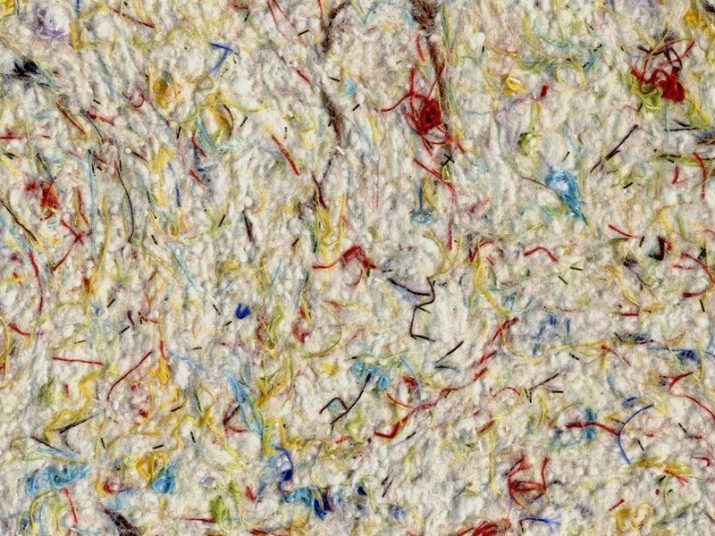
Application technology
Liquid wallpaper is an environmentally friendly finishing material that even novice craftsmen can use.

Before proceeding with the application of wallpaper plaster, it is necessary to complete all work related to the installation of communication systems.
The main stages of the work:
- surface cleaning and elimination of all major defects;
- painting of all metal parts;
- applying an antiseptic solution;
- covering the working area with a primer;
- production of working material;
- applying the composition to a wall with a thickness of no more than 0.3 cm.

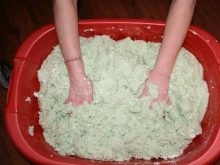

If the work is carried out with a hard trowel, then the walls will have a smooth texture, and with the help of a roller, structural patterns can be created.

Despite the simplicity of applying this composition to the walls, professional craftsmen recommend paying attention to the following recommendations:
- mandatory cleaning of the working surface from construction debris and dust;
- application of special acrylic primers with deep penetration effect;
- mixing the material with water only by hand without using tools that can damage fine threads;
- re-mixing the composition 25 minutes after preparing the liquid mixture;
- regular wetting of working tools with water;
- using transparent spatulas;
- to obtain a perfectly flat surface, you can use a construction roller;
- alignment of corners and all protruding areas with a spatula;
- creation of the most favorable conditions for faster drying of working surfaces.


For aesthetic surface decoration, designers recommend using two methods of applying a graphic pattern:
- stencil;
- author's.
To apply a pattern to the walls using special stencils, you must first glue the base layer of the finishing material and dry it thoroughly, and only then proceed to transfer the pattern through the stencil, which is fixed to the wall only with masking tape.

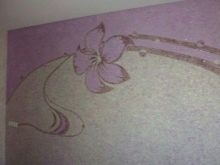

The creation of author's images and patterns is a more painstaking measure, which involves the initial drawing of the outline of the drawing with pencils on the prepared surface. Painting patterns should be started from the largest areas, gradually moving to smaller areas. Experts recommend starting to apply a new layer only after the previous one has completely dried, to prevent mixing of colors at their border. You can use a regular wet cloth to remove excess wallpaper.



Selection and operation rules
So that the selected product does not disappoint with its quality and the result obtained, professional builders recommend using the following guidelines:
- purchase of goods of only well-known trade brands;
- unwanted use of cellulose wallpaper for kitchen decoration;
- to obtain an exclusive color, you must independently mix the white mixture with the coloring pigment;
- applying only a homogeneous composition to the walls;
- using only certified and not expired goods.
In order to extend the life of liquid wallpaper, it is necessary to properly care for them.
Wet cleaning is permissible only if the wall surface is covered with a protective layer of varnish. Dust from untreated wallpaper can only be removed with a vacuum cleaner. If the surface is still wet, then it is strictly forbidden to touch it until it is completely dry.
The following factors can spoil the appearance of this coating:
- direct sunlight;
- mechanical damage with sharp objects;
- heat;
- swipe.

Interesting ideas
This type of finishing material allows designers to design a kitchen space in any stylistic direction with a minimum expenditure of financial resources and time.
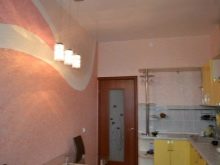


An effective combination of a white kitchen with blue facades will make it possible to decorate one of the walls with wallpaper of the same tone, which will add elegance to the room and fill it with air.
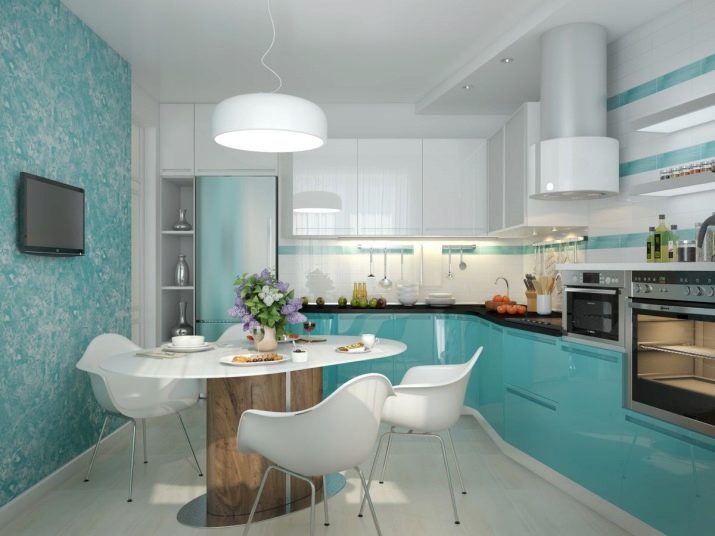
The use of steel or rich gray wallpaper in the design of the kitchen will help to complement the high-tech stylistic direction, which will make the room modern and unusual.
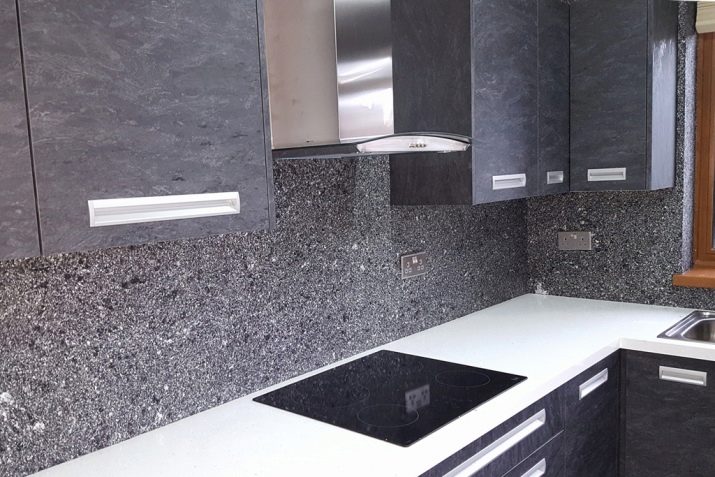
The ability to create any graphic images is the main advantage of this material, which is used by designers when working on complex projects.


Renovation is not only a difficult and tedious process associated with a lot of financial costs, but also a creative project that allows the owners of the premises to maximize their design talents. To decorate the kitchen space, experts recommend, first of all, to use new and modern finishing materials, which will make it possible to realize all interesting ideas. One of the unusual materials for the kitchen is liquid wallpaper, which is in great demand every year. But before you start gluing wallpaper, you need to study the technology for performing work, as well as purchase a quality product of a well-known brand.



For more information on liquid wallpaper for the kitchen, see the next video.








